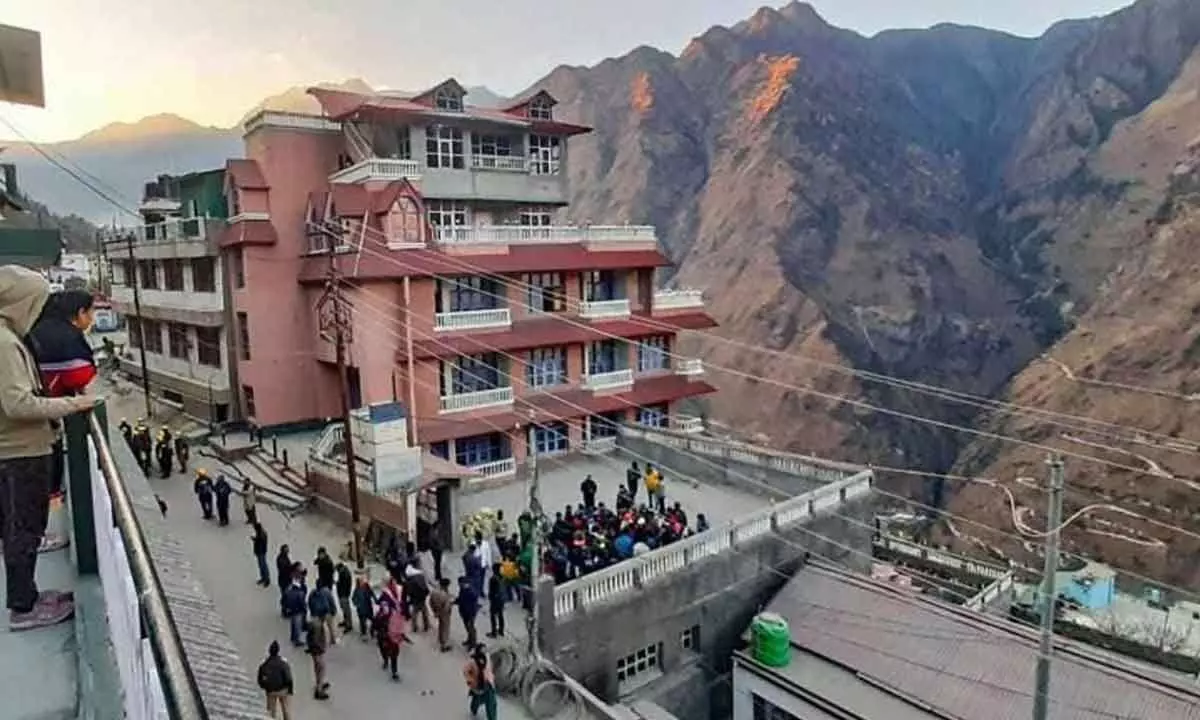Live
- Hyderabad Achieves 26% Reduction in PM10 Levels in 2023-24, Improving Air Quality
- Tired And Stressed As A Parent? Try These Easy Life Hacks
- Supreme Court issues notice on PIL seeking directions to integrate legal education, self-defence training into school curriculum
- Oneplus 13 Launch: OnePlus Vows Snapdragon 8 Elite and Hasselblad Cameras
- Bengal school jobs case: Arpita Mukherjee granted bail; new HC Bench to look into Partha Chatterjee's plea
- Working to provide social security for gig and platform workers: Govt
- Bangladesh records 11 dengue deaths, toll rises to 459
- Vocera Raises $500K from Y Combinator to Revolutionize Voice AI Testing and Evaluation
- GQG Partners Refuses to Sell Adani Stocks Despite Bribery Scandal and 26% Loss
- Bihar: Four persons including girl injured in post bypolls violence in Gaya
Just In
Unchecked pilgrimage & construction spell disaster for Himalayas


Increasing influx of thousands of pilgrims per day to Badrinath and other pilgrimage sites, along with a surge in the number of vehicles and heedless construction projects in the vicinity, is posing a significant threat to the ecological and biological diversity of the region
New Delhi: Crumbling mountainsides, sinking towns and untrammeled construction. It is against this backdrop that thousands of pilgrims make their way to the upper reaches of Uttarakhand each day, posing serious risk to the fragile Himalayan region, say experts.
That reports of landslides are increasing and people in subsidence-hit Joshimath, the gateway to Badrinath, one of the Char Dham destinations, are being compelled to move back to the homes they left because of large cracks add to the general sense of foreboding gripping the area. Environmentalists point to the road expansion project as another factor posing a serious risk to the stability of the region, already highly prone to climate-driven disasters, experts say. The Uttarakhand government’s decision to lift the daily cap on the number of pilgrims visiting the state for the Char Dham Yatra is a matter of grave concern, according to environmental activist Atul Sati.
Earlier, the daily limits were — Yamunotri (5,500 pilgrims), Gangotri (9,000), Badrinath (15,000) and Kedarnath (18,000).
“The increasing influx of thousands of pilgrims per day to Badrinath and other pilgrimage sites, along with a surge in the number of vehicles and heedless construction projects in the vicinity, is posing a significant threat to the ecological and biological diversity of the region,” Sati said.
“On May 4, a mountain crumbled in Helang on the way to Joshimath while road widening was taking place. After Joshimath, the land is sinking in many other places in Uttarakhand. Every day we hear about people losing lives due to landslides on the roads,” he added.
Geologist C P Rajendran said the attendant problem of higher footfall is the generation of huge amounts of waste, including plastics and horse and donkey excreta.
The heavy pilgrim traffic, he explained, could also result in the melting of glaciers and environmental degradation with a serious impact on biodiversity. “Many higher altitude areas in the Uttarakhand Himalayas host rare medicinal plants that are facing serious extinction threat due to climate change coupled with the dumping of waste,” Rajendran said.
A 2019 report headed by veteran environmentalist Ravi Chopra described the Char Dham project — an ongoing road project that will connect the four important pilgrim towns of Badrinath, Kedarnath, Gangotri, and Yamunotri — as “an assault on the Himalayas”.
The committee recommended limiting road widths to 5.5 meters on the Char Dham project. However, in December 2021, the Supreme Court in its order allowed the road width to 10 meters. Environment researcher Abhijit Mukherjee noted that a primary reason for landslides in the Himalayas is because road widening cuts away the toe of slopes that support the rocks.
This in turn destabilises the mountain area. “I would imagine the mega-road constructions going on in the surrounding of Char Dham have certainly developed such ill-supported slopes which are absolutely prone to sliding and sinking,” Mukherjee, professor of Geology and Geophysics at Indian Institute of Technology (IIT) Kharagpur, said.
He explained that several hydropower projects being built in the Uttarakhand-Himachal Pradesh region in recent times involve building a dam or barrage, and this has its own perils. “While these dams or barrages are important to engineer the river by building a reservoir, what it also does is disturb the natural hydrologic equilibrium of the slopes with the rivers,” he added.
Sati said reports of accidents have increased due to continuous stone shooting and mountain crumbling. “It is more important to make traffic safe than widening the road,” he said. In his view, authorities have not taken adequate measures to address the environmental and safety concerns of both the pilgrims and the local community.

© 2024 Hyderabad Media House Limited/The Hans India. All rights reserved. Powered by hocalwire.com






